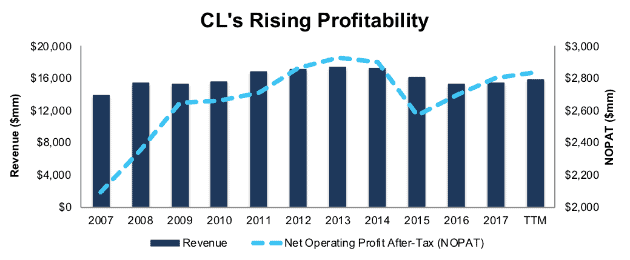Two new stocks make September’s Exec Comp Aligned with ROIC Model Portfolio, available to members as of September 14, 2018.
Recap from August’s Picks
Our Exec Comp Aligned with ROIC Model Portfolio (+1.3%) underperformed the S&P 500 (+2.5%) last month. The best performing stock in the portfolio was up 9%. Overall, six out of the 15 Exec Comp Aligned with ROIC Stocks outperformed the S&P in August, and nine had positive returns.
The success of this Model Portfolio highlights the value of our Robo-Analyst technology[1], which scales our forensic accounting expertise (featured in Barron’s) across thousands of stocks.
This Model Portfolio only includes stocks that earn an Attractive or Very Attractive rating and align executive compensation with improving ROIC. We think this combination provides a uniquely well-screened list of long ideas because return on invested capital (ROIC) is the primary driver of shareholder value creation.[2]
New Stock Feature for September: Colgate-Palmolive (CL: $69/share)
Colgate-Palmolive (CL) is the featured stock in September’s Exec Comp Aligned with ROIC Model Portfolio. Colgate was previously featured as a Long Idea in May 2018.
Over the past decade, CL has grown revenue by 1% compounded annually and after-tax operating profit (NOPAT) by 3% compounded annually. CL’s NOPAT margin has improved from 15% in 2007 to 18% over the trailing twelve months (TTM) and it has generated free cash flow (FCF) of $12.7 billion (21% of market cap) over the past five years.
Figure 1: CL’s Revenue & NOPAT Since 2007
Sources: New Constructs, LLC and company filings
Executive Compensation Plan Helps Drive Shareholder Value Creation
Colgate-Palmolive has used ROIC to determine executive salaries, annual bonuses, and long-term incentives since 2014. This focus on improving ROIC aligns the interests of executives and shareholders and helps ensure prudent stewardship of capital. Shareholders can be confident that CL executives will avoid overpriced acquisitions like Newell’s (NWL) deal for Jarden. We believe this superior corporate governance is an underrated competitive advantage.
CL’s executive compensation plan lowers the risk of investing in the company’s stock because we know executives’ interests are tied to real value creation.
Valuation Still Provides Upside Potential
At its current price of $69/share, CL has a price-to-economic book value (PEBV) ratio of 1.3. This ratio means the market expects CL’s NOPAT to grow by no more than 30% over the remainder of its corporate life. Such an expectation seems pessimistic given that CL has grown NOPAT by 6% compounded annually since 1998.
If CL can maintain TTM pre-tax margins and can grow NOPAT by 5% compounded annually for the next decade, the stock is worth $86/share today – a 25% upside. See the math behind this dynamic DCF scenario.
In the meantime, investors receive a 2.4% dividend yield.
Critical Details Found in Financial Filings by Our Robo-Analyst Technology
As investors focus more on fundamental research, research automation technology is needed to analyze all the critical financial details in financial filings. Below are specifics on the adjustments we make based on Robo-Analyst findings in Colgate-Palmolive’s 2017 10-K:
Income Statement: we made $1.0 billion of adjustments, with a net effect of removing $777 million in non-operating expense (5% of revenue). You can see all the adjustments made to CL’s income statement here.
Balance Sheet: we made $7.6 billion of adjustments to calculate invested capital with a net increase of $4.7 billion. One of the largest adjustments was $3.9 billion due to other comprehensive income. This adjustment represented 42% of reported net assets. You can see all the adjustments made to CL’s balance sheet here.
Valuation: we made $10.4 billion of adjustments with a net effect of decreasing shareholder value by $9.4 billion. Apart from $7.5 billion in total debt, which includes $642 million in operating leases, one of the largest adjustments to shareholder value was $1.8 billion in underfunded pensions. This adjustment represents 3% of CL’s market cap. Despite the net decrease in shareholder value, CL remains undervalued.
This article originally published on September 19, 2018.
Disclosure: David Trainer, Kyle Guske II, and Sam McBride receive no compensation to write about any specific stock, style, or theme.
Follow us on Twitter, Facebook, LinkedIn, and StockTwits for real-time alerts on all our research.
[1] Harvard Business School features the powerful impact of our research automation technology in the case New Constructs: Disrupting Fundamental Analysis with Robo-Analysts.
[2] Ernst & Young’s recent white paper, “Getting ROIC Right”, proves the superiority of our research and analytics.

